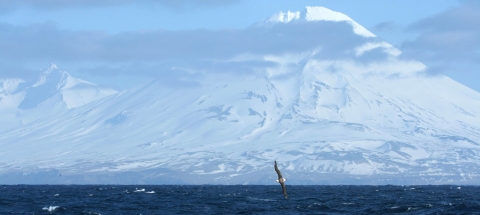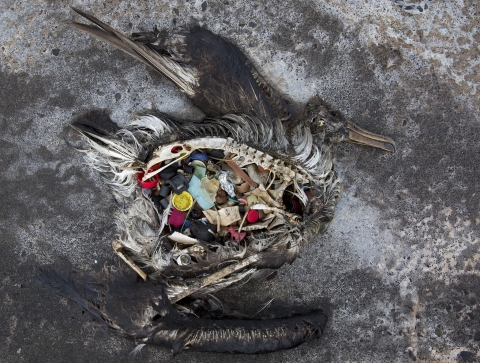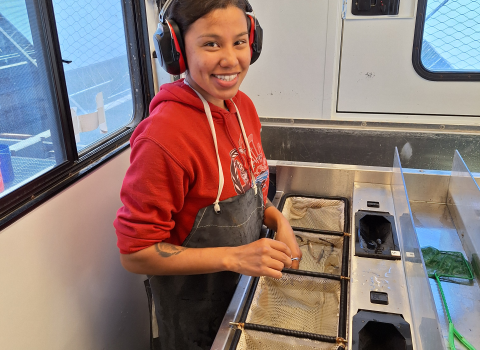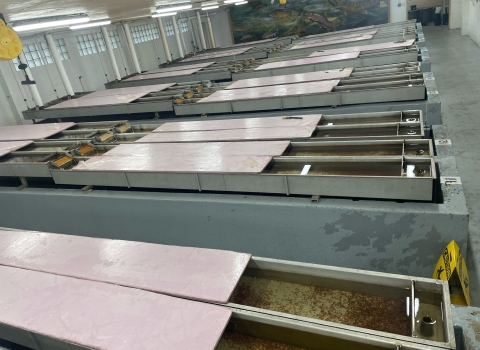When hearing the word albatross, some might think of a really good round of golf (three under par). Like scoring an albatross in golf, sighting a long-lived master of flight in the Albatross family is a special treat. Chances are you haven’t seen one in person, but to put a name to this special type of seabird opens the door to their world.
Masters of Efficient Flight
There are 22 species of albatross that share the gift of efficient long-distance gliding flight. They are famously recognized by their lengthy wingspans with the Wandering Albatross holding the record at nearly 12 feet. These remarkable wingspans are vital for a lifetime at sea. With the help of air currents and temperature changes, these wings are able to provide enormous amounts of lift; albatross can spend hours in flight without rest or a single flap. Their flying abilities allow albatross to journey thousands of miles across open oceans.
Old Souls
Many people view their elders and put some thought into what those eyes have seen over a lifetime; what experiences that person has had, or wisdom and knowledge they’ve picked up through the years. These same thoughts could be applied when looking into the eyes of an albatross. Albatross can live decades and spend most of their long lives at sea. When an albatross encounters a fishing vessel or is counted on the breeding grounds, these birds may be decades older than the people studying these magnificent gliders. It could be safe to assume that an adult albatross knows their way around the seas better than the career fisherman or woman they are following.
Throughout history, humans have shared the seas with these seabirds. Many sailors recognize that albatross will follow their vessels, looking for an easy meal. Interactions, intentional or accidental, have resulted in the near-extinction of some species of albatross. Conservation efforts have been put in place by multi-nation partnerships, which have contributed to success in rising numbers of albatross seen in the Pacific Ocean.
Albatrosses in Alaska
Alaska is within the range of Short-tailed, Laysan and Black-footed Albatross which are commonly seen at-sea. These birds take to land to breed on ocean islands, including the world’s largest albatross colony on Midway Atoll National Wildlife Refuge.
Short-tailed Albatrosses
This endangered species breeds primarily on two remote islands in the western Pacific with the majority (~85%) breeding on Torishima, Japan (an active volcano in the Izu Island Group, northwest of Taiwan). From 2008 to 2012 the U.S. Fish and Wildlife Service and Japanese partners at the Yamashina Institute for Ornithology worked together to establish a third breeding colony by translocating chicks from Torishima to a historic breeding location on the island of Mukojima. Recently, short-tailed albatrosses have also successfully bred on Midway Atoll.
Short-tailed Albatrosses generally head toward their feeding grounds around April and May, but have been known to make the long journey into Alaskan waters just to feed and return to their nest. They have been seen feeding along shelf breaks in the Bering Sea and Gulf of Alaska, along the Aleutian Islands, and southeast Alaska. They also occur along the Pacific coasts of Canada and the United States including waters along Washington, Oregon, and California.
Short-tailed Albatross follow fishing vessels and are sometimes hooked or entangled in longline fishing gear and drowned. The U.S. Fish and Wildlife Service has been working with the commercial fishing industry, Washington Sea Grant, and National Marine Fisheries Service to minimize take of this endangered seabird. Through this collaborative conservation effort, a type of seabird avoidance technology called “streamerlines” was developed to reduce the bycatch of albatrosses.
Streamerlines create a visual barrier that keeps seabirds away from the baited hooks. In Alaska, streamerlines deployed on fishing vessels has led to a major reduction in the bycatch of albatrosses. Fishermen who have used streamerlines to ward off seabirds say there is also a financial benefit: the streamer lines keep seabirds from swiping their bait, saving them money in the long run.
From near extinction at the turn of the 20th century, to being listed as endangered throughout its range in 2000, the population of short-tailed albatross continues to grow with a current estimate of 7,365 individuals and a population growth rate of 8.9%. This is something to celebrate.
Black-footed Albatross
Unlike the Short-Tailed Albatross, the Black-footed Albatross is not currently listed as threatened or endangered under the Endangered Species Act (ESA). Black-Footed Albatross are only found in the Pacific Ocean with breeding populations located on the Hawaiian and Japanese islands. Breeding occurs from late fall to mid-summer and involves a colorful display of head bobs, wing flaps, and foot stomps. If you have not witnessed a Black-Footed Albatross mating dance, that should be your next internet search as it is a sight to see. Black-footed Albatross, like other albatross species, are thought to mate for life but will find a new mate if their partner disappears or passes away.
After breeding these seabirds can be seen in the North Pacific where they feed on fish, squid, and crustaceans. Like other albatross species, these birds can also be seen tailing ships for easy meals and have sometimes become victims to accidental entanglement into fishing equipment at sea. They too have benefited from Short-tailed Albatross conservation efforts via reduced accidental bycatch.
Laysan Albatross
One of the easier identifiable albatross seen in the seas surrounding Alaska is the Layson Albatross. These seabirds are generally smaller in size when compared to other albatross sharing its range, but is most noticeably different by its white belly and head that is often referred to as “gull-like”. Add in a gray-brown wings with white undersides and a dark tail and you’ve got yourself a Laysan Albatross.
Laysan Albatross are more commonly seen out at sea away from North American shores. 97.7% of the population call the northwestern Hawaiian Islands home during the breeding season (late fall to mid-summer) before moving north through the Pacific eventually making their way to Alaskan fishing regions. For those of you traveling through the southwest, don’t be too surprised to see one of these seabirds overhead, they’ve been known to wander inland during their migration north.
These seabird’s have a diet consisting of squid, fish, crustaceans and flying fish eggs. They primarily feed at night. In regards to fishing bycatch, this could be beneficial or negative depending on fishing operation times and the effectiveness and use of mitigating equipment such as streamers at night. Like other albatross, Laysan Albatross sometimes fall victim to fishing equipment such as baited lines and driftnets. They have also benefited from conservation efforts to reduce seabird bycatch during fishing operations. Fishing bycatch, however, is not the only issue that Laysans and other sea life must face, plastics and debris scattered through the world’s oceans are also part of this seabird’s diet, which in many cases can prove to be fatal.
A note on plastic pollution: Be Part of the Solution
Like many birds, albatross can fall victim to plastic pollution that makes its way to sea. Because they feed along the surface on squid, krill, fish eggs and other items, albatrosses often accidentally swallow floating plastic. This becomes a problem when their stomach becomes impacted and full of plastic resulting in lack of nutrition from natural prey. On the breeding grounds, baby albatrosses suffer from a diet of this plastic trash brought in by their parents from the ocean. Parents feed their chicks by regurgitating what they’ve found out at sea. It’s estimated that adult albatrosses unwittingly bring back thousands of pounds of marine debris back to places like Midway atoll every year. Dead chicks that have starved due to plastic ingestion can be found on the breeding grounds and are testament to this global problem.One way you can make a small difference is picking up plastic trash before it makes its way into rivers and eventually to sea.
You can help albatross and all seabirds by recycling as much or your plastic as possible, saying ‘no’ to single use plastic, using a re-usable water bottle, bringing re-usable bags to the grocery store. We can all do our part to help make the oceans safe for all birds and ensure that the graceful flight of the albatross can be witnessed by generations to come.
In Alaska we are shared stewards of world renowned natural resources and our nation’s last true wild places. Our hope is that each generation has the opportunity to live with, live from, discover and enjoy the wildness of this awe-inspiring land and the people who love and depend on it.











